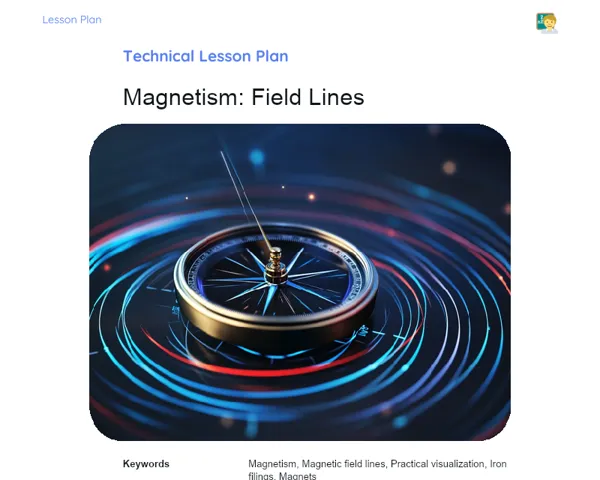Lesson Plan | Lesson Plan Tradisional | Geometric Optics: Apparent Position
| Keywords | Geometric Optics, Apparent Position, Light Refraction, Snell's Law, Refractive Index, Position Calculation, Practical Examples, Solved Problems, Contextualization, Curiosity, Student Engagement |
| Resources | Whiteboard and markers, Projector, Presentation slides, Diagrams illustrating light refraction, Calculators, Transparent glasses filled with water, Submerged objects (e.g., coins, spoons), Paper and pens for note-taking |
Objectives
Duration: (10 - 15 minutes)
This stage aims to provide a clear and comprehensive overview of the key concepts that will be covered in the lesson. It will help students understand the expectations for the lesson's conclusion and the significance of this topic within Physics. Setting clear objectives will also aid the teacher in organizing and delivering the lesson effectively, ensuring all critical points are addressed.
Objectives Utama:
1. Explain the concept of the apparent position of a submerged object in various media.
2. Demonstrate how to calculate the real and apparent position of an object using geometric optics principles.
3. Present practical examples and tackle problems involving light refraction in different media.
Introduction
Duration: (10 - 15 minutes)
🎯 Purpose: The goal of this introduction is to create an engaging context for the topic of Apparent Position. By linking the subject to real-life examples and interesting facts, students will be more engaged and interested, making them appreciate its relevance in daily life and Physics. This setup will also pave the way for more in-depth explanations throughout the lesson.
Did you know?
🔍 Curiosity: Did you know this same principle applies to eyeglass lenses and cameras? Light refraction is crucial for vision correction and capturing clear images. Plus, understanding the apparent position of submerged objects is vital for activities like fishing, where the fish's actual position in the water differs from what we perceive.
Contextualization
📚 Context: To kick off the lesson on Geometric Optics and Apparent Position, introduce students to the interesting behavior of light as it transitions between different media. Use relatable scenarios, like how a spoon seems 'broken' when placed in a glass of water. This visual effect is due to light refraction, which changes the path of light rays when moving from one medium to another with varying refractive indexes.
Concepts
Duration: (40 - 50 minutes)
🎯 Purpose: This segment aims to deepen students' understanding of apparent position and light refraction. Covering essential topics and using practical examples enables students to link theory to real-life situations, enhancing their problem-solving skills concerning refraction and apparent positioning. Engaging in class-based problem-solving allows students to practice learned concepts and clarify any confusion, ensuring a solid grasp of the material.
Relevant Topics
1. 📘 Law of Refraction (Snell's Law): Explain that as light travels from one medium to another, its speed changes, resulting in a change in the direction of light rays. The relationship between the angles of incidence and refraction is expressed by Snell's Law: n1sin(θ1) = n2sin(θ2), where n represents the refractive index of the medium.
2. 📘 Refractive Index: Highlight that the refractive index denotes how light moves in a medium. It’s the ratio of the speed of light in a vacuum to its speed in the medium. Common refractive indices include air (about 1), water (around 1.33), and glass (approximately 1.5).
3. 📘 Apparent Position: Clarify that the apparent position is where an observer thinks a submerged object is located due to light refraction. Utilize diagrams to show how light bends when transitioning from water to air, making the object seem nearer to the surface than it is.
4. 📘 Calculating Real and Apparent Position: Teach students to employ Snell's Law to derive the real position of a submerged object based on its apparent position and the other way around. Provide formulas and practical examples to simplify the calculations.
5. 📘 Practical Examples: Use relatable examples like spotting a coin at the bottom of a water glass and fishing, where fish seem to be in different positions than their actual locations. Solve related problems in detail, explaining each step.
To Reinforce Learning
1. 1️⃣ A coin lies at the bottom of a glass of water (refractive index = 1.33). If the actual depth of the coin is 6 cm, what is the perceived depth when observed straight down?
2. 2️⃣ A stick partially submerged in water makes an angle with the surface. Draw a diagram to display the light rays' path and clarify why the stick looks broken.
3. 3️⃣ A fish is located 2 meters deep in a lake. Calculate the apparent depth when viewed directly from above, considering the refractive index of water as 1.33.
Feedback
Duration: (20 - 25 minutes)
🎯 Purpose: This stage aims to help students solidify their understanding of the concepts discussed in the lesson through detailed discussions on the questions addressed. Reviewing answers and explanations enables the teacher to clarify doubts and reinforce critical points. Additionally, engaging students with reflective questions promotes deeper and contextualized comprehension, encouraging them to think critically about the subject matter.
Diskusi Concepts
1. 1️⃣ Question 1: A coin lies at the bottom of a glass of water (refractive index = 1.33). If the real depth of the coin is 6 cm, what is the apparent depth when viewed vertically?
Explanation: We can calculate the apparent depth using the refraction formula. The relation between real depth (d_real) and apparent depth (d_apparent) is:
d_apparent = d_real / n
By substituting values, we get: d_apparent = 6 cm / 1.33 ≈ 4.51 cm. Thus, the apparent depth is roughly 4.51 cm. 2. 2️⃣ Question 2: A stick is partially submerged in water, forming an angle with the surface. Draw a diagram illustrating the light rays' path and expound on why the stick appears broken.
Explanation: The diagram should show light rays bending at the water-air boundary. Light rays moving from the stick into the air change direction crossing the surface due to differing refractive indexes. This creates the illusion that the submerged portion of the stick is in a different position from the above-water part, giving the impression that it is broken. The angular change can be explained using Snell's Law. 3. 3️⃣ Question 3: A fish is situated at a 2-meter depth within a lake. Compute the apparent depth when viewed directly from above (assuming the refractive index of water is 1.33).
Explanation: Once again, we apply the refraction formula to find the apparent depth. Here, d_real = 2 m and n = 1.33. Using the formula:
d_apparent = d_real / n
Thus, substituting values gives us: d_apparent = 2 m / 1.33 ≈ 1.50 m. Hence, the apparent depth of the fish is approximately 1.50 m.
Engaging Students
1. ❓ Why is the perceived depth often less than the actual depth when viewing a submerged object? 2. ❓ How can light refraction influence accuracy in activities like fishing or photography underwater? 3. ❓ If the refractive index of water increases, how would that impact the apparent position of submerged objects? 4. ❓ Can the concept of apparent position be applied in contexts other than water? What could those contexts be?
Conclusion
Duration: (10 - 15 minutes)
The goal of this conclusion stage is to reinforce the lessons learned by summarizing key points and enhancing understanding of the concepts covered. Additionally, by relating theory to practical applications and emphasizing the topic's importance, this stage solidifies knowledge and showcases how these concepts are applicable in students' everyday experiences.
Summary
['Light refracts when moving from one medium to another with different refractive indices, altering its path.', "Snell's Law correlates the angles of incidence and refraction through the media's refractive indices.", 'The apparent position of a submerged object is where the observer believes the object is because of light refraction.', "The real and apparent positions can be calculated using Snell's Law and the refractive indices involved.", "Real-world examples, like observing submerged coins or fishing, demonstrate how objects' perceived positions change due to refraction."]
Connection
The lesson tied together the principles of light refraction and Snell's Law with everyday examples—like viewing submerged objects and fishing. By solving real problems, students grasped the practical application of theoretical concepts, strengthening their understanding of the apparent positioning of submerged objects.
Theme Relevance
This topic holds significance in our daily lives, as light refraction impacts various activities, from observing underwater objects to fishing and designing glasses and cameras. Comprehending refraction and apparent position helps clarify visual phenomena we encounter regularly and enhances precision in tasks that require underwater vision.



